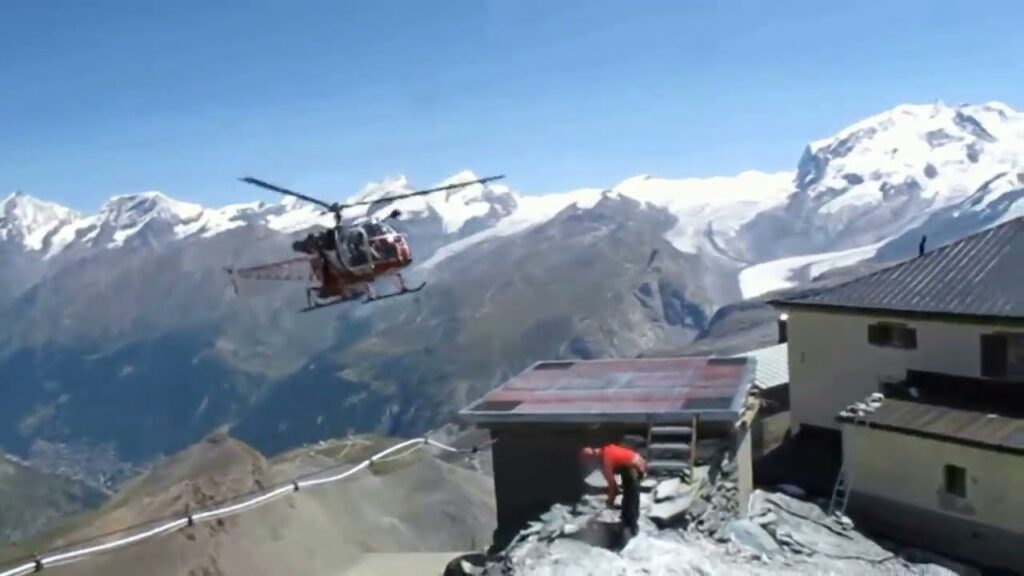History and Development of the Aérospatiale SA 315B Lama
The Aérospatiale SA 315B Lama was born out of a unique requirement for a helicopter capable of high-altitude performance, particularly suited for the challenging terrains of the Himalayas. In the late 1960s, the Indian government sought a helicopter that could operate effectively in the extreme conditions found in the mountainous regions. The French company Aérospatiale responded to this demand by developing the SA 315B Lama, which was introduced in 1969. This helicopter was a hybrid design, combining the airframe of the Aérospatiale Alouette II with the more powerful engine of the Alouette III, resulting in an aircraft that could perform in altitudes over 20,000 feet.
The development of the SA 315B Lama was a testament to engineering innovation, addressing the need for a versatile and reliable helicopter. Aérospatiale’s design team focused on enhancing the helicopter’s lift capacity and stability in thin air, which was crucial for operations in the Himalayas. The helicopter was equipped with a Turbomeca Artouste IIIB turboshaft engine, renowned for its robust performance and reliability. The combination of a lightweight frame and powerful engine enabled the Lama to achieve feats that were previously unattainable for helicopters, such as setting a world altitude record in 1972 when it reached a height of 12,442 meters (40,814 feet).
The success of the Aérospatiale SA 315B Lama was not limited to its high-altitude capabilities. Its development process also emphasized adaptability and efficiency, allowing it to be used in a variety of roles beyond mountain rescue and transport. The helicopter’s design made it suitable for tasks such as agricultural work, aerial photography, and construction operations. Over the years, the Lama’s reputation for ruggedness and versatility has led to its widespread use in numerous countries, solidifying its place in the annals of aviation history as a pioneering high-altitude helicopter.
Specifications and Performance of the Aérospatiale SA 315B Lama
The Aérospatiale SA 315B Lama is a light utility helicopter that is renowned for its exceptional high-altitude performance and versatility. Designed primarily for operations in challenging environments, the SA 315B combines the airframe of the Alouette II with the dynamic components of the Alouette III, creating a robust aircraft that excels in mountainous regions. Powering the Lama is the Turbomeca Artouste IIIB turboshaft engine, which delivers an impressive 550 shaft horsepower. This engine not only provides the necessary thrust for high-altitude operations but also ensures reliability in various climatic conditions.
Performance-wise, the Aérospatiale SA 315B Lama is designed to operate at altitudes exceeding 20,000 feet, making it a preferred choice for missions in the Himalayas and the Andes. Its hover ceiling in ground effect is approximately 16,400 feet, while out of ground effect, it maintains a hover ceiling of about 13,000 feet. These capabilities are complemented by a maximum speed of 192 km/h (119 mph) and a range of approximately 515 kilometers (320 miles), making it suitable for a variety of tasks including search and rescue, medical evacuation, and transport.
In terms of specifications, the SA 315B Lama has a maximum takeoff weight of 2,300 kg (5,070 lbs), and it can accommodate a pilot and up to four passengers or an equivalent cargo load. The helicopter’s rotor system features a three-blade main rotor and a two-blade tail rotor, which contribute to its agile handling and stability in turbulent conditions. Its compact dimensions, with an overall length of 10.24 meters (33 feet 7 inches) and a rotor diameter of 11.02 meters (36 feet 2 inches), allow it to access confined landing sites that are often encountered in rugged terrains.
The Aérospatiale SA 315B Lama is celebrated for its rugged construction and adaptability, enabling it to perform a wide range of missions under challenging conditions. Its high-altitude performance, combined with its reliability and ease of maintenance, have made it a favorite among operators who require a dependable and versatile helicopter. Whether used for civilian or military purposes, the SA 315B Lama continues to be a testament to innovative helicopter engineering and design.
Unique Features of the Aérospatiale SA 315B Lama
The Aérospatiale SA 315B Lama is renowned for its distinctive design and engineering, which were specifically tailored to meet the demands of high-altitude flight. One of the most unique features of the Lama is its exceptional performance in mountainous regions, a capability that stems from its combination of the Alouette II’s airframe and the Alouette III’s more powerful engine. This fusion allows the helicopter to operate efficiently in thin air, making it an ideal choice for operations in the Himalayas and other high-altitude environments.
Another standout characteristic of the SA 315B Lama is its robust and versatile airframe. Designed to withstand the rigors of both civilian and military use, the helicopter’s structure is optimized for carrying heavy loads. It can be configured to transport cargo, passengers, or even medical patients, showcasing its adaptability across various mission profiles. The Lama’s airframe is complemented by its simple yet effective landing gear, which enables it to take off and land on uneven and rugged terrain with ease.
The helicopter’s rotor system also contributes to its unique operational capabilities. Featuring a three-blade main rotor and a two-blade tail rotor, the SA 315B Lama offers excellent maneuverability and stability, even in challenging weather conditions. This rotor configuration not only enhances the helicopter’s performance but also contributes to its reputation for reliability and safety, making it a trusted choice for search and rescue missions, aerial surveys, and agricultural applications.
Current Applications and Uses of the Aérospatiale SA 315B Lama
The Aérospatiale SA 315B Lama, renowned for its exceptional high-altitude performance, continues to serve a variety of critical roles across different sectors. One of its primary applications is in aerial work, where it excels in tasks such as power line inspection, pipeline surveillance, and firefighting. Its robust design and ability to hover with precision make it an ideal choice for these demanding operations. Moreover, its capability to operate in extreme temperatures and at altitudes as high as 20,000 feet ensures that it remains a valuable asset for missions in challenging terrains.
In the realm of search and rescue (SAR) operations, the SA 315B Lama is a trusted asset. Its agility and reliability are crucial in mountainous regions, where it is often deployed to locate and rescue stranded individuals. The helicopter’s compact size and powerful engine allow it to access remote areas that are otherwise unreachable by ground vehicles, making it indispensable for emergency response teams. The ability to carry out rescues at high altitudes further underscores its value in SAR missions, particularly in regions like the Himalayas and the Andes.
The helicopter also plays a significant role in tourism and adventure sports. Operators in countries with expansive mountain ranges utilize the SA 315B Lama to offer scenic flights, providing tourists with breathtaking aerial views of natural landscapes. Additionally, its use in heli-skiing operations is noteworthy, where it transports skiers to otherwise inaccessible peaks, offering them the thrill of skiing down untouched snow. The Lama’s combination of power, reliability, and versatility ensures that it remains a preferred choice for operators in these recreational industries.
The Legacy and Impact of the Aérospatiale SA 315B Lama in Aviation
The Aérospatiale SA 315B Lama has left a profound legacy in the world of aviation, primarily due to its remarkable versatility and high-altitude performance. Originally designed in the late 1960s, the Lama combined the best features of its predecessors, the Alouette II and Alouette III, to create a helicopter capable of operating in the most challenging environments. Its ability to fly at altitudes exceeding 25,000 feet made it an invaluable asset for mountainous regions and rescue missions. The Lama’s robust design and adaptability have earned it a legendary status, allowing it to remain in service for decades across various countries and industries.
One of the most significant impacts of the SA 315B Lama is its role in shaping search and rescue operations. The helicopter’s unique capability to perform in extreme altitudes and harsh weather conditions made it an essential tool for missions in the Himalayas, Andes, and other mountainous regions worldwide. Its powerful engine and lightweight frame allowed it to reach areas that were previously inaccessible, significantly improving the success rates of rescue operations. The Lama’s influence extended beyond civilian use, as it also became a vital component in military operations, further solidifying its reputation as a reliable and indispensable aircraft.
In addition to its operational achievements, the Aérospatiale SA 315B Lama has had a lasting impact on helicopter design and engineering. Its innovative combination of a lightweight airframe and a powerful engine set new standards for high-performance helicopters. The Lama’s success inspired further advancements in helicopter technology, influencing the development of subsequent models and contributing to the evolution of rotary-wing aircraft. Its legacy is evident in the continued use of similar design principles in modern helicopters, underscoring the Lama’s enduring influence in the aviation industry.

